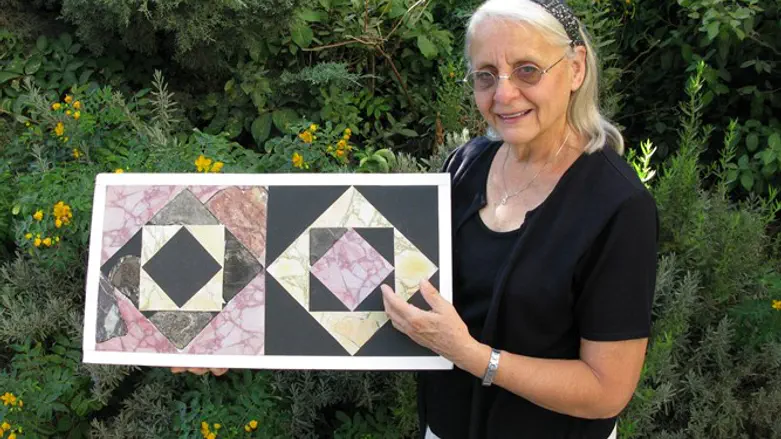
At the Temple Mount Sifting Project at the Emek Tzurim national park in Jerusalem, some 600 colored stone tiles have been revealed.
100 of them have been definitively dated to the time of the Second Temple, based on their measurements which correspond both to the Roman foot (which measured 29.6 cm) and to other tiles found in the Herodian palaces at Masada, Herodion, Jericho, and other locations.
Additionally, the dating is based on similar styles of floor tiles discovered in palaces and villas in Italy which have also been dated back to the Herodian period.
The original floor tiles will be presented to the public on Thursday at the City of David National Park at the annual Archaeological meeting of the Megalim institute.
The floor tiles were made from different types of marble and from colorful stones which were imported from Rome, Asia Minor, Tunisia, and Egypt. They were cut in different geometric patterns.

Recently a researcher from the sifting project, Franki Schneider, an expert on decorative ancient floors, succeeded in reconstructing some of the magnificent examples of tiles from the Temple Mount courtyards.
Schneider, who began her work at Emek Tzurim as a volunteer 9 years ago, has a background in mathematics and Jewish studies and used her broad professional knowledge to make a precise reconstruction of the tiles.
She says that "This type of flooring was called Sectilia, which means 'Act of cutting' and was extremely prestigious, being preferred to the regular mosaic floors."
Schneider says that she has discovered seven potential patterns of floor tiles which decorated the Temple Mount. She says that these floorings were probably set by foreign artisans sent by the Roman caesar Augustus to his friend Herod, who rebuilt the Temple Mount in the first century B.C.E.
The patterns include interlaced squares, triangles, stars and other shapes which have been meticulously cut in a way that they correspond perfectly to one another so that "even the blade of a knife would not fit between them," says Schneider.
Tzachi Devira, the joint director of the sifting project, says that no previous research had focused on the types of floorings which existed on the Temple Mount.
The concept of floorings being done through the Sectilia method first emerged in a publication by Asaf Avraham, an archeologist who today supervises the national park surrounding the walls of Jerusalem and the Emek Tzurim national park via the Parks Authority.
Assaf based his ideas on Josephus's depiction of the courtyard as "tiled with stones of various different colors" (Wars of the Jews, 5:2).
The Talmudic tradition also tells of stones on Temple Mount built of different types of colored marble (Sukkah 51b; Bava Batra 4a).
Dr. Gabi Barkai, the initiator of the Temple Mount sifting project, said that "Now, due to Franki Schneider's mathematical skills, we have succeeded in reconstructing the patterns themselves. This the first time that we can see with our own eyes the magnificence of the floors which decorated the Temple and its courts two thousand years ago. Regarding the temple that Herod built, the Talmud says that 'Whoever did not see the building that Herod built has never seen an attractive building in his life.'
"We may not have seen the Temple in its glory, but now with the discovery of these special floorings we can at least get an inkling of one aspect of the glory of the second Temple", says Barkai.
The Temple Mount Sifting Project is the countermeasure to Muslim attempts to erase Jewish history on the Temple Mount. There has never been organized authorized archaeological dig on Judaism's holiest site, because the Muslim Wakf, to whom jurisdiction over the site was returned after the Six Day War victory for Israel, would not allow it. Instead, in 1999, the Wakf conducted far-reaching renovations on the Temple Mount in order to create a large underground mosque below today's Al-Aqsa Mosque which can hold thousands of worshipers. In order to prepare the large prayer area, the Muslim Waqf illegally removed thousands of tons of earth from the Mount.
This earth, which had lain for many generations on the south side of the Mount, had concealed within it thousands of impressive, historical artifacts from every period in which the Temple Mount had been active. Hundreds of trucks tipped the earth into Nachal Kidron (at the start of the work, some of the trucks had been sent to the Abu Dis garbage dump in East Jerusalem in order to hide the evidence of illegal digging).
After the matter became known, it was all carefully gathered up and moved to Emek Tzurim National Park to be sifted, sorted and painstakingly studied as part of a formidable scientific project led by Dr. Gabriel Barkay and the archaeologist Tzachi Devira.